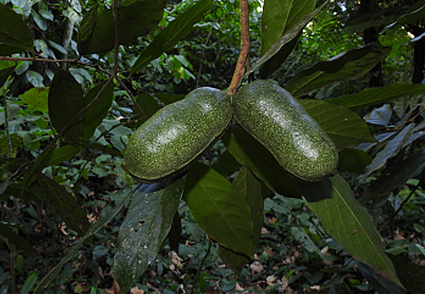Abstract
Tridimeris is the only genus of Annonaceae endemic to Mexico. Despite this, the genus has been largely ignored and very little is known about it; specifically its diversity and distribution in Mexico are not well studied. Here a new species of Tridimeris, T. huatuscoana, is described and illustrated. The most general characteristics of the new species confirm that dimerous flowers (two sepals and four petals) and the large, and fleshy fruits are the most obvious synapomorphies for the Mexican genus Tridimeris. With respect to the other two species described so far (Tridimeris hahniana and T. chiapensis), the new species can be easily distinguished by the unique combination of 2-flowered inflorescences, large petals pubescent outside, food bodies present at the base of its inner petals, setose leaf domatia, and fruits shortly pedunculate and stipitate. The new species expands the richness of the genus to three species, all endemic to Mexico and restricted to montane cloud forests.
References
Baillon, H.E. (1869) Sur un nouveau genre d’ Annonacées a fleurs diméres et unicarpellées. Adansonia 9: 219.
Britton, N.L. & Rose, J.N. (1928) North American Flora 23 (1): 29.
Candolle, A. (1868) Prodromus Systematis Naturalis Regni Vegetabilis 16 (2): 657.
Candolle, C.D. (1878) Meliaceae. Flora Brasiliensis 11 (1): 205. https://doi.org/10.1111/j.1095-8339.1878.tb00037.x
Castillo-Campos, G. García-Franco, J. & Martínez, M.L. (2013) Spathacanthus magdalenae sp. nov. (Acanthaceae), a riparian forest species from Veracruz, México. Nordic Journal of Botany 31 (4): 449. https://doi.org/10.1111/j.1756-1051.2013.00118.x
Decaisne, J., Planchon, J.É. (1854) Revue Horticole (Paris) 16: 108.
Fries, R.E. (1900) Der Süd-amerikanischen annonaceen. Kongliga Svenska Vetenskaps Academiens Handlingar, Ny Följd 34 (5): 12.
Donoghue, M.J. (1985) A critique of the biological species concept and recommendations for a phylogenetic alternative. The Bryologist 88: 172–181. https://doi.org/10.2307/3243026
Hanstein, J. (1865) Die Gesneraceen des Königlichen herbariums und der Gärten zu Berlin nebst monographischer uebersicht der Familie im ganzen. Linnaea 34 (3): 284–286.
Humboldt, A. von, Bonpland, A. & Kunth, K. (1819) Nova Genera et Species Plantarum (quarto ed.) 3 (11): 245.
IUCN (2022) The IUCN Red List of Threatened Species (Version 2021-3). Available from: https://www.iucnredlist.org/resources/categories-and-criteria (accessed 30 May 2022)
Lau, J., Pang, CC., Ramsden, L. & Saunders, R.M.K. (2016) Reproductive resource partitioning in two sympatric Goniothalamus species (Annonaceae) from Borneo: floral biology, pollinator trapping and plant breeding system. Scientific Reports 6: 35674. https://doi.org/10.1038/srep35674
Linnaeus, C. (1753) Species Plantarum 2: 628.
Moricand, M.É. (1837) Plantes Nouvelles d’Amérique. pp. 39, t. 26.
Murray, J.I. (1923) Diagnoses and notes relating to the Spermatophytes chiefly of North America. Contributions from the Gray Herbarium of Harvard University 68: 86.
Ortiz-Rodriguez, A.E, Escobar-Castellanos, M.A & Pérez-Farrera, M. A (2016a) Phylogenetic analyses and morphological characteristics support the description of a second species of Tridimeris (Annonaceae). PhytoKeys 74: 79–85. https://doi.org/10.3897/phytokeys.74.10371
Ortiz-Rodriguez, A.E., Ruiz-Sanchez, E. & Ornelas, J.F. (2016b) Phylogenetic relationships among members of the Neotropical clade of Miliuseae (Annonaceae): generic non-monophyly of Desmopsis and Stenanona. Systematic Botany 41: 815–822. https://doi.org/10.1600/036364416X693928
Ortiz-Rodriguez, A.E., Ornelas, J.F. & Ruiz-Sanchez, E. (2018) A jungle tale: molecular phylogeny and divergence time estimates of the Desmopsis–Stenanona clade (Annonaceae) in Mesoamerica. Molecular Phylogenetics and Evolution 122: 80–94. https://doi.org/10.1016/j.ympev.2018.01.021
Ramírez-Barahona, S. & Eguiarte, L.E. (2013) The role of glacial cycles in promoting genetic diversity in the Neotropics: the case of cloud forests during the Last Glacial Maximum. Ecology and Evolution 3: 725–738. https://doi.org/10.1002/ece3.483
Safford, W.E. (1916) Desmopsis, a new genus of Annonaceae. Bulletin of the Torrey Botanical Club 43: 183–193. https://doi.org/10.2307/2479760
Schatz, G.E. (1998) New species of Sapranthus B. C. Seemann and Unonopsis R. E. Fries (Annonaceae) from Mesoamerica. Novon 8: 436–440. https://doi.org/10.2307/3391870
Schatz, G.E., Maas, P.J.M., Maas-van de Kamer, H., Westra, L.Y.T. & Wieringa, J.J. (2018) Revision of the Neotropical genus Sapranthus (Annonaceae). Blumea 63: 54–66. https://doi.org/10.3767/blumea.2018.63.01.06
Schlechtendal, D. (1836) De plantis Mexicanis a G. Schiede M. Dre. Collectis nuntium adfert D.F.L. de Schlechtendl. Linnaea 10: 241.
Seemann, B. (1866) On Sapranthus, a new genus of Annonaceae from Central America. Journal of Botany 4: 369.
Standley, P.C. (1929) Studies of American plants I. Publications of the Field Columbian Museum, Botanical Series 4: 205–208.
Thiers, B. (2022) Index Herbariorum: A global directory of public herbaria and associated staff. New York Botanical Garden’s Virtual Herbarium. Available from: http://sweetgum.nybg.org/science/ih/ (accessed 23 February 2022)
Toledo, V.M. (1976) Los cambios climáticos del Pleistoceno y sus efectos sobre la vegetaci6n tropical cálida y húmeda de México. Thesis, Universidad Nacional Autónoma de México. Ciudad de México, México.


